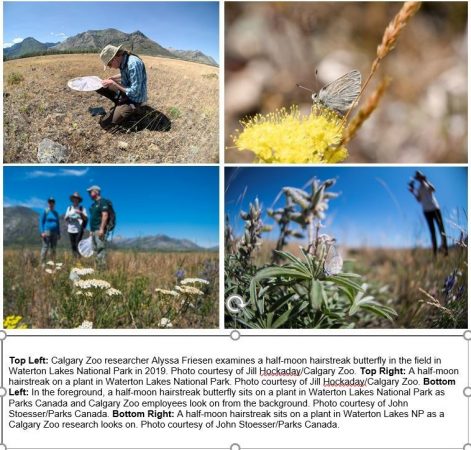
Parks Canada and the Calgary Zoo conserving endangered butterfly in Waterton Lakes National Park
by CM Staff

Waterton Lakes National Park supporting three-year program with $289,800 contribution

Parks Canada and the Calgary Zoo conserving endangered butterfly in Waterton Lakes National Park (CNW Group/Parks Canada)
WATERTON PARK, Alta. — On Jan. 13, it was announced that Parks Canada and the Calgary Zoo are working together to conserve and restore the endangered half-moon hairstreak butterfly population in Waterton Lakes National Park. Parks Canada is contributing $289,000 and in-kind support to the Calgary Zoo for this three-year project.
“National parks play an important role in addressing the impacts of climate change, protecting our biodiversity and contributing to the recovery of species at risk,” said Jonathan Wilkinson, minister of Environment and Climate Change and Minister responsible for Parks Canada, in a prepared statement. “Parks Canada is pleased to partner with the Calgary Zoo to support the survival of the half-moon hairstreak butterfly in Waterton Lakes National Park. Together, we are protecting our natural environment, and the wildlife that call it home, for generations to come.”
The half-moon hairstreak (Satyrium semiluna) is a small, brown butterfly listed as an endangered species under the Species at Risk Act (SARA). The only location where this butterfly is known to exist in Alberta is in Waterton Lakes National Park in the Blakiston Fan, a grassland area along the entrance road to the park.
This collaboration between Parks Canada and the Calgary Zoo will advance longer-term population monitoring and will greatly improve our understanding of the life history of the half-moon hairstreak butterfly. The project will also support the collection of genetic material to assess the possibility of wild-to-wild translocations of butterflies from other populations in B.C. or Montana. Expected research activities will include examining the duration of life stages, survival rates, larval behaviour, interactions with ants, and egg over-wintering conditions. Conservation activities will include assessing and restoring the butterfly’s habitat and managing invasive plants.